by Roger Hare, rhare[at]talk21[dot]com
Last modified: 8 September 2003
Roger Hare's Shogi Pages are brought to you by
![]() the portal to the wonderful
world of Shogi.
the portal to the wonderful
world of Shogi.
|
Dai Shogi by Roger Hare, rhare[at]talk21[dot]com Last modified: 8 September 2003 Roger Hare's Shogi Pages are brought to you by
|
| Contents |
| Introduction to Dai Shogi |



|
|
Dai Shogi is played on a 15x15 board and the promotion zone comprises the five ranks furthest away from each player. It is thought to have been played without drops.
Dai Shogi equipment is available from G Hodges.
| Dai Shogi - The Board |



|
|
The board looks like this:

The board is 15 'squares' by 15, but otherwise is the same as a shogi board The circular points are to mark promotion zones and to enable you to visually divide the board up easily. The letters and numbers are for notational purposes - eg: the top right square is a1, the bottom left is o15, and so on. As usual, black plays 'up' the board, and white plays 'down' the board.
| Dai Shogi - The Pieces |



|
|
The diagrams below are scanned in (with permission) from the leaflet describing Dai Shogi which is supplied by G F Hodges. The quality of the scanned images leaves something to be desired, but this is unavoidable due to the resolution of the scanner I am using.
In what follows, the moves of the pieces are described as if the piece were `black', ie: playing `up' the board. To get the move for the white piece, simply rotate all directions (and the piece!) through 180 degrees.
There are 3 types of piece: Step movers, Ranging movers and Jumping movers.
A circle meanst that the piece can move to the square so marked (step
mover).
An arrow means the piece may move any number of squares in that
direction (ranging mover).
A cross means that the piece may move to that square, jumping other
pieces if necessary (jumping mover).
The shincho and its move look like this:


The shincho moves one square in an orthogonal directio. Initially, each side has two shincho. Black's shincho are sited at m4 & m12, white's shincho at c4 & c12. The shincho promotes to Gold General.
The kakugyo and its move look like this:

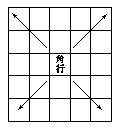
The kakugyo moves any number of squares in a diagonal direction. Initially, each side has two kakugyo. Black's kakugyo are sited at l5 & l11, white's kakugyo at d5 & d11. The kakugyo promotes to Dragon Horse.
The moko and its move look like this:


The moko moves one square in any direction except n. Initially, each side has two moko. Black's moko are situated at n7 & n9, white's moko at b7 & b9. The moko promotes to Flying Stag.
The myojin and its move look like this:


The myojin moves one square in a diaogonal direction. Initially, each side has two myojin. Black's myojin are situated at n3 & n13, white's myojin at b3 & b13. The myojin promotes to Gold General.
The dosho and its move look like this:


The dosho moves one square in a n-w, n, n-e or s direction. Initially, each side has two dosho. Black's dosho are situated at l10 & l3, white's dosho at a10 & a3. The dosho promotes to Side Mover.
The ryume and its move look like this:

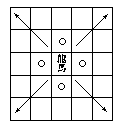
The ryume may move any number of squares in a diagonal direction, plus one square orthogonally. Initially, each side has two ryume. Black's ryume are situated at l6 & l10, white's ryume at d6 & d10. The ryume promotes to Horned Falcon.
The ryuo and its move look like this:

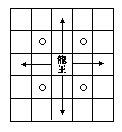
The ryuo may move any number of squares in an orthogonal direction, plus one square diagonally. Initially, each side has two ryuo. Black's ryuo are sited at l7 & l9, white's ryuo at d7 & d9. The ryuo promotes to Soaring Eagle.
The suizo and its move look like this:


The suizo moves a single square in any direction except s. Initially, each side has a single suizo. Black's suizo is situated at n8, white's at b8. The suizo promotes to Crown Prince.
The akuro and its move look like this:


The akuro moves one square in any of the forward or sideways directions, that is, , n-w, n, n-e, e. Initially, each side has two akuro. Black's akuro are situated at m6 & m10, white's at c6 & c10. The akuro promotes to Gold General.
The mohyo and its move look like this:


The mohyo moves one squere in any of the forward or backwards directions, that is, n-w, n, n-e, s-w, s, s-e. Initially, each side has two mohyo. Black's mohyo are situated at n5 & n11, white's at b5 & b11. The mohyo promotes to Bishop.
The hiryu and its move look like this:

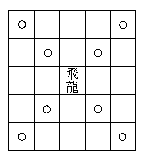
The hiryu moves one or two squares in any diagonal direction. Initially, each side has two hiryu. Black's hiryu are situated at l2 & l14, white's at d2 & d14. The hiryu promotes to Gold General.
The hon'o and its move look like this:

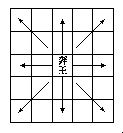
The hon'o noves any number of squares in any orthogonal or diagonal direction. Initially, each side has one hon'o. Black's hon'o is situated at l8, white's at d8. The hon'o does not promote.
The chunin and its move look like this:


The chunin moves one square orthogonally forwards or backwards, ie: n or s. Initially, each side hs two chunin. Black's chunin are situated at j5 & j11, white's at f5 & f11. The chunin promotes to Drunk Elephant.
The kinsho and its move look like this:


The kinsho moves one square in any direction except the two backwards diagonals, ie: 1 square in a n-w, n, n-e, e, s, w direction. Initially, each side has two kinsho. Black's kinsho are situated at o7 & o9, white's at a7 & a9. The kinsho promotes to Rook.
The tessho and its move look like this:


The tessho moves one square in any forward direction, ie: 1 square in a n-w, n, n-e direction. Initially, each side has two tessho. Black's tessho are situated at o4 & o12, white's at a4 & a12. The tessho promotes to Gold General.
The osho and its move look like this:
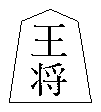

The osho moves one square in any direction. Each side has one osho. Black's osho is situated at o8, white's at a8. The osho does not promote.
The keima and its move look like this:


The keima moves one square forward and then one square diagonally, left or right (ie: a restricted form of the knights move in Chess), that is, one square n followed by one square n-w or n-e. Pieces on the intervening squares are ignored. Initially, each side has two keima. Blacks keima are located at o2 & o14, white's at a2 & a14. The keima promotes to Gold general.
The kirin and its move look like this:

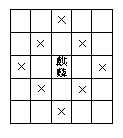
The kirin may move (jumping if necessary) two squares in an orthogonal direction (n, s, e, w) or one square in a diagonal direction (n-w, n-e, s-e, s-w). Initially, each side has one kirin. Blacks kirin is located at m9, white's at c7. The kirin promotes to Lion.
The kyosha and its move look like this:


The kyosha may move any number of squares in a forwward (ie: n) direction. Initially, each side has two kyosha. Blacks kyosha are located at o1 & o15, white's at a1 & a15. The kyosha promotes to White Horse.
The shishi and its move look like this:

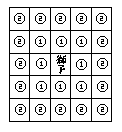
The shishis move is complicated!
the shishi may move to a (1) square or jump diectly to a (2) square,
capturing or not
the shishi may capture at a (1) square and then move to an adjacent (1) or
(2) square without further capture
the shishi may capture two enemy pieces at adjacent (1) & (1) or (1) & (2)
squares
the shishi may capture at a (1) square and then return to its starting
position, thus capturing without moving
the shishi may move to a vacant (1) square and then return to its starting
position, thus skipping a move
Each side has one shishi.
Blacks shishi is located at m8, white's at d8.
The shishi does not promote.
The fuhyo and its move look like this:


The fuhyo may move one square forward (ie: n). Initially, each side has 15 fuhyo. Blacks fuhyo are located at k1-15, white's at e1-15. The fuhyo promotes to gold general.
The hoo and its move look like this:

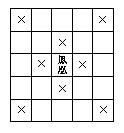
The hoo may move one square orthogonally (n, s, e, w) or two squares diagonally (jumping if necessary). Each side has one hoo. Blacks hoo is located at at m7, white's at c9. The hoo promotes to Free King.
The hansha and its move look like this:


The hansha may move any number of squares orthogonally forward or backward (ie: n or s). Each side has two hansha. Blacks hansha are located at n1 & n15, white's at b1 & b15. The hansha promotes to Whale.
The hisha and its move look like this:

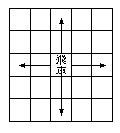
The hisha may move any number of squares in an orthogonal direction (ie: n, s, e, w). Each side has two hisha. Blacks hisha are located at l1 & l15, white's at d1 & d15. The hisha promotes to Dragon King.
The ogyo and its move look like this:


The ogyo may move one square forwards or backwards (n, s) or any number of squares sideways (e, w). Each side has two ogyo. Blacks ogyo are located at l3 & l13, white's at d3 & d13. The ogyo promotes to Free Boar.
The sekisho and its move look like this:


The sekisho may move one square diagonally forwards, ie: n-w, n-e. Each side has two sekisho. Blacks sekisho are located at o3 & o13, white's at a3 & a13. The sekisho promotes to Gold General.
The ginsho and its move look like this:


The ginsho may move one square diagonally or orthogonally forwards or one square diagomnally backwards, ie: n-w, n, n-e, s-e, sw. Each side has two ginsho. Blacks ginsho are located at o6 & o10, white's at a6 & a10. The ginsho promotes to Vertical Mover.
The mogyu and its move look like this:

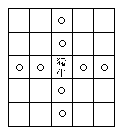
The mogyu may move two squares forwards or sideways, ie: n, s, e, w. Each side has two mogyu. Blacks mogyu are located at m2 & m14, white's at c2 & c14. The mogyu promotes to Gold General.
The kengyo and its move look like this:


The kengyo may move any number of squares orthogonally forwards or backwards (n or s) or one square orthogonally sideways (w or e). Each side has two kengyo. Blacks kengyo are situated at l4 & l12, whites at d4 & d12. The kengyo promotes to Flying Ox.
The taishi and its move look like this:


The taishi may move one square in any direction (n, n-e, e, s-e, s, s-w, w, n-w). The taishi is a promoted Drunk Elephant.
The hiroku and its move look like this:


The hiroku mau move any number of squares orthogonally forwards or backwards (n or s), or one square diagonally backwards or forwards (n-e, s-e, s-w or n-w), or one square orthogonally sideways (w or e). The hiroku is a promoted Blind Tiger.
The higyu and its move look like this:

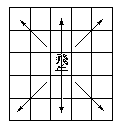
The higyu may move any number of squares diagonally or orthogonally backwards or forwards. The higyu is a promoted Vertical Mover.
The honcho and its move look like this:

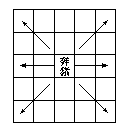
The honcho may move any number of squares diagonally forwards or backwards or orthogonally sideways. The honcho is a promoted Side Mover.
The kakuo and its move look like this:

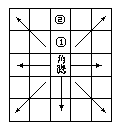
The kakuo may move any number of squares in any diagoonal or orthogonal direction except forwards. Orthogonally forwards, it may move to (2) with a jump or to (1). The kakuo is a promoted Dragon Horse.
The tokin and its move look like this:


The tokin moves one square in any direction except the two backwards diagonals, ie: 1 square in a n-w, n, n-e, e, s, w direction. The tokin is a promoted pawn.
The hiju and its move look like this:

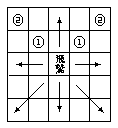
The hiju may move any number of squares orthogonally sideways or forwards (n, s, e or w), or diagonally backwards (s-e or s-w), or diagonally forward (n-w or n-e) to a(1) square or a (2) square with a jump. The hiju is a promoted Dragon King.
The keigei and its move look like this:

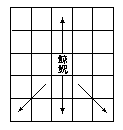
The keigei may move any number of squares orthogonally backwards or forwards (n or s), or diagonally backwards (s-e or s-w). The keigei is a promoted Reverse Chariot.
The hakku and its move look like this:

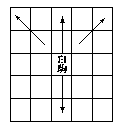
The hakku may move any number of squares orthogonally backwards or forwards (n or s), or diagonally forwards (n-e or n-w). The hakku is a promoted Lance.
| Dai Shogi - The Starting Set-Up and Notation |



|
|
The diagram below was scanned in (with permission) from the leaflet describing Dai Shogi which is supplied by G F Hodges.
At the start of play, the board is set up like this:

Notation
Dai shogi notation is the same algebraic form as that of shogi.
| Dai Shogi - The Rules |


|
|
Dai-shogi rules are the same as for normal Shogi except that drops are not allowed.